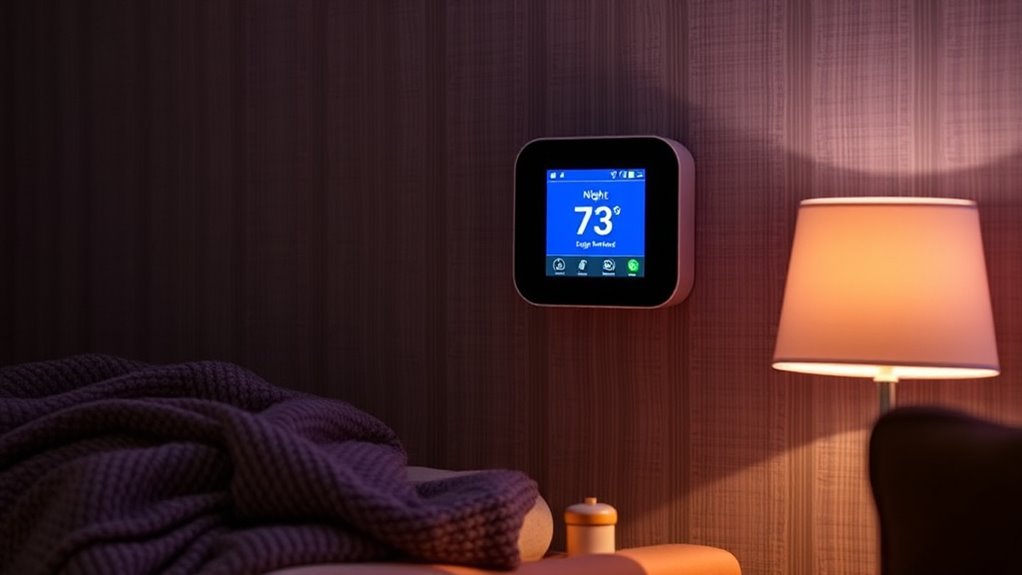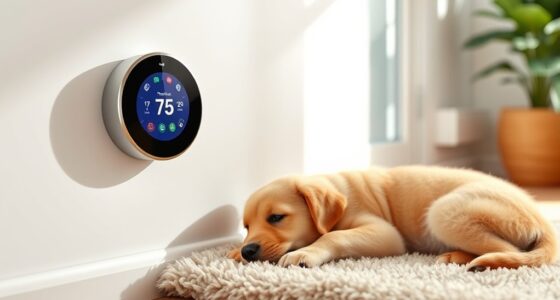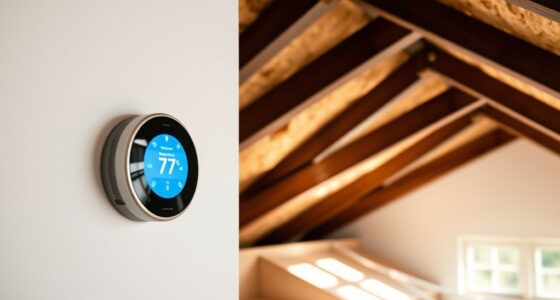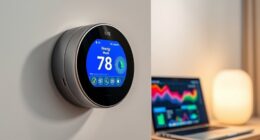To optimize your smart thermostat for nighttime, set it around 65°F (18°C) in winter and about 78°F (26°C) in summer for comfort and energy savings. Use automation features like scheduling or adaptive recovery to maintain consistent temperatures that match your sleep habits. Utilize sensors and learn your routines to prevent unnecessary heating or cooling. Mastering these strategies not only improves your sleep quality but also cuts your energy bills—keep exploring for more tips.
Key Takeaways
- Set your thermostat to around 65°F (18°C) in winter and 78°F (26°C) in summer for optimal sleep comfort and energy savings.
- Use automated schedules and adaptive recovery features to maintain consistent, comfortable nighttime temperatures automatically.
- Leverage learning capabilities of smart thermostats to analyze habits and adjust settings for personalized comfort.
- Incorporate sensors or motion detectors to prevent heating or cooling unoccupied rooms during nighttime.
- Sync your thermostat with sleep trackers to optimize temperature based on individual sleep cycles and improve overall rest quality.

Setting the right nighttime temperature with your smart thermostat can substantially improve your sleep quality and save energy. When you optimize your home’s temperature during the night, you not only create a more comfortable environment but also reduce unnecessary energy consumption. A well-programmed smart thermostat ensures that your heating or cooling system operates efficiently, avoiding wasteful cycles that drive up your energy bills. This balance between comfort and efficiency is key to achieving energy savings without sacrificing restful sleep.
Optimizing nighttime temperatures with a smart thermostat enhances sleep quality and reduces energy costs efficiently.
To get the most out of your smart thermostat, consider setting a slightly cooler temperature during winter nights and a warmer one in summer. For instance, lowering your thermostat to around 65°F (18°C) during winter can promote better sleep while conserving energy. In summer, setting it to about 78°F (26°C) when you’re asleep helps keep your room comfortable without overworking your AC. Many smart thermostats allow you to create automated schedules, so you don’t have to remember to adjust the temperature manually. This automation is vital for comfort optimization because it ensures your home maintains the perfect climate throughout the night, adapting to your sleep patterns and preferences.
Another strategy involves utilizing your thermostat’s learning capabilities. Most smart thermostats analyze your habits over time and automatically adjust settings for maximum comfort and energy efficiency. You can also enable features like adaptive recovery, which ensures your home reaches the desired temperature just before you wake up or go to bed, rather than running continuously all night. This approach minimizes energy waste and maintains a cozy atmosphere, helping you fall asleep faster and stay comfortable throughout the night. Additionally, incorporating energy-efficient devices can further optimize your home’s overall energy consumption, complementing your thermostat’s settings.
Furthermore, integrating your smart thermostat with other smart home devices can enhance your nighttime temperature strategy. For example, using window sensors or motion detectors can prevent your system from heating or cooling unoccupied rooms, further boosting energy savings. If you have a sleep tracker, some advanced thermostats can sync with it to fine-tune the temperature based on your sleep cycles, ensuring maximum comfort and efficiency. Additionally, understanding the importance of high-quality projectors can inspire you to optimize your home environment for better relaxation and entertainment during your waking hours. Recognizing that precise temperature control is vital can help you create a more comfortable and energy-efficient living space.
Frequently Asked Questions
How Do Smart Thermostats Learn My Temperature Preferences?
Smart thermostats learn your temperature preferences through advanced learning algorithms that track your adjustments over time. As you set different temperatures, the device creates personalized temperature profiles, understanding your habits and routines. By analyzing this data, it automatically adjusts the temperature to match your comfort levels, saving energy and ensuring your home stays cozy. Over time, it becomes more accurate, making your environment perfectly tailored to your lifestyle.
Can I Control My Thermostat Remotely?
Yes, you can control your thermostat remotely. Many smart thermostats offer voice control, allowing you to adjust the temperature hands-free through devices like smart speakers. You can also use a mobile app for manual adjustment from anywhere, giving you full control even when you’re away. This makes it easy to set the perfect temperature without needing to physically access the thermostat, enhancing comfort and energy efficiency.
What Is the Ideal Nighttime Temperature for Energy Savings?
Imagine the cozy comfort of your home at night, where cooler air whispers through the temperature zones. To maximize energy efficiency, set your thermostat around 65°F, striking a balance between comfort and savings. This temperature helps your HVAC work less while keeping your space comfortable. You can control your thermostat remotely to adjust these settings, ensuring you enjoy peaceful nights and lower energy bills effortlessly.
How Do Smart Thermostats Improve Sleep Quality?
You improve your sleep quality by creating an ideal sleep environment and ensuring bedroom comfort. Smart thermostats help you achieve this by automatically adjusting the temperature to your preferred level, maintaining consistent comfort throughout the night. This stability reduces disturbances, helping you fall asleep faster and enjoy deeper sleep cycles. With a smart thermostat, you can customize your nighttime temperature, ensuring your bedroom stays cozy and conducive to restful sleep.
Are There Any Safety Concerns With Programmable Thermostats?
When it comes to programmable thermostats, safety concerns are minimal if you use them correctly. They help with temperature regulation, preventing overheating or extreme cold that could cause health issues or damage. Modern models often include safety features like alerts for system malfunctions or temperature anomalies. To stay safe, guarantee your thermostat is correctly installed, updated, and monitored, so you avoid potential risks associated with improper temperature control.
Conclusion
So, you’ve mastered your smart thermostat’s nighttime settings, saving energy while staying cozy—yet here’s the irony: the more you optimize, the more you might find yourself obsessing over every degree. Perhaps, in trying to outsmart your heating system, you’ve unintentionally turned into a thermostat whisperer. But hey, if you’ve achieved perfect comfort and efficiency, maybe you’ve finally proven that sometimes, the smartest move is simply trusting your tech—and letting it do the work.









